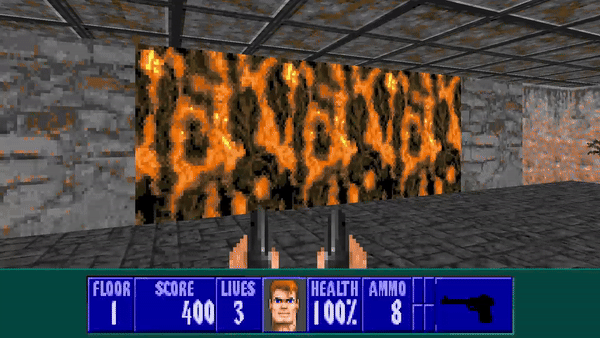The MAPINFO file is capable of holding a lot more than the basics covered here, including changes to difficulty select, automap and intermission screens. You can learn about all the different elements of MAPINFO on the ECWolf Wiki.
The MapInfo file can be one of the most important in an ECWolf project, as it will contain core information about your game. This file will tell ECWolf how to group and order your episodes and maps, as well as various other core settings.
Let's look at the example version provided by Dunkelschwamm in his guide:
clearepisodes
episode "EXAMPLE"
{
lookup = "WL_EPISODE1"
picname = "M_EPIS1"
key = "E"
}
cluster 1
{
exittext = "ENDART1"
exittextislump
}
map "EXAMPLE"
{
next = "EXAMPLE"
secretnext = "EXAMPLE"
floornumber = 1
par = 90
music = "GETTHEM"
cluster = 1
}
This is effectively a blank slate - clearepisodes removes the existing episodes, then a new episode is created, linking to the map "EXAMPLE" as the starting map in the episode.
A cluster is also defined - this allows a mod project to wrap sets of levels with intermission screens at the start or end, allowing for chances to portray additional game information or story elements through text as the game progresses.
The "EXAMPLE" map is then given variables, such as what map to follow with, and if it is part of a cluster.
You can learn the process of adding maps and making basic changes to your MapInfo file by following Dunkelschwamm's guide on creating a mapset for ECWolf.
Global properties - The gameinfo structure
The gameinfo structure in MAPINFO is used to hold a lot of global properties about the game, including menu colours and music, "player classes", and more.
Unless specified, ECWolf will assume the default options of the base game being modded.
As an example, if the following gameinfo structure is put in your mod it will make two changes. It will make menu options blue (which looks ugly, but this is just an example), and disable the Read This! in-game manual:
gameinfo
{
menufontcolor_label = "DarkBlue"
drawreadthis = false
}
There are a lot of things that can be tweaked in the gameinfo structure, and you can find out more about them on the ECWolf Wiki's Gameinfo page.



